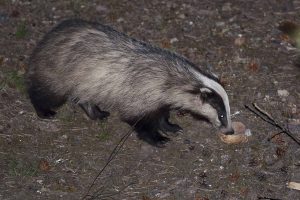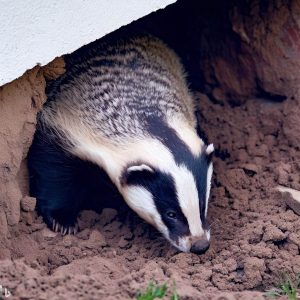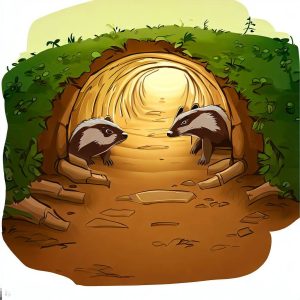Badgers are a protected species in many countries, where they are known for their distinctive black and white striped faces, kind of like a Panda. However, badgers are also known to cause damage to property and can be a disturbance to farmers and homeowners. This has led to a debate over whether badgers should be culled or relocated to manage their populations.
But how do you get rid of a badger under the house?
What is the best method to deter badgers?
Badgers are nocturnal animals that live in underground burrows, known as setts. They are omnivorous and primarily feed on earthworms, insects, and small mammals. Badgers are also known to prey on ground-nesting birds and their eggs, which has led to concerns about their impact on local wildlife populations. Additionally, badgers can cause damage to crops and gardens with their digging and tunneling activities. Evidence of badgers can include tracks, droppings, and damaged property.

My Personally Proven Method to Scare Away Badgers
Cinnamon, Garlic, Cayenne Pepper, and Curry Powder
(wrapped in a paper towel)
One effective way to deter badgers from your property is by using a mixture of cinnamon, garlic, cayenne pepper, and curry powder. Here’s how to do it:

- Mix equal parts of cinnamon, garlic, cayenne pepper, and curry powder in a bowl.
- Take a paper towel and place a tablespoon of the mixture in the center.
- Wrap the paper towel around the mixture and tie it with a string.
- Place the wrapped mixture in the areas where badgers are known to frequent.
The strong smell of the mixture is what keeps the badgers away. This method is safe and non-toxic, making it a great alternative to chemical-based repellents.
It’s important to note that while I have proven this method to be effective, it may not work for everyone. Badgers are intelligent animals and may become accustomed to the smell over time. It’s also important to handle the underlying causes of why badgers are attracted to your property, such as food sources or shelter.

In addition to using this method, it’s recommended to keep your property clean and free of potential food sources for badgers. This includes securing trash cans, removing pet food from outside, and sealing any openings in your home or shed where badgers may be able to enter.
By using a combination of prevention methods and natural repellents, you can effectively deter badgers from your property without causing harm to the animals.
Brief Overview of the Problem (Badgers Under Your House)

Badgers are known to cause significant damage to homes and properties. They are known to burrow under houses, sheds, and other structures, creating tunnels and dens. This can lead to structural damage and compromise the safety of the building. In addition, badgers can also cause damage to gardens, lawns, and other outdoor areas.
When badgers burrow under a house, they can cause serious problems. The tunnels they create can weaken the foundation of the building, leading to cracks and other structural damage. This can be costly to repair and may even lead to the need for a complete rebuild of the affected area.
In addition to structural damage, badgers can also cause other problems. They are known to carry diseases, such as tuberculosis, which can be transmitted to humans and pets. Badgers can also attract other wildlife, such as foxes and rats, which can cause additional damage and carry their own set of diseases.
If you suspect that badgers are living under your house, it’s important to take action as soon as possible. Ignoring the problem can lead to more significant damage and costly repairs. There are a variety of methods for safely and effectively removing badgers from under your house, including using humane traps and deterrents.
Overall, dealing with badgers under your house can be a challenging and potentially dangerous problem. it’s important to take the necessary steps to remove them safely and prevent future infestations.
Identifying Badgers
Signs of Badgers

Identifying badgers is essential before trying to get rid of them. Badgers are usually active at night, which makes them difficult to spot. However, there are some signs that can help you identify their presence.
One of the most common signs of badgers is their burrows, which are usually located in grassy areas or near woodlands. Badgers are known for digging complex burrow systems that can have multiple entrances and chambers. These caves can be identified by the presence of large holes in the ground, which are usually surrounded by piles of earth.
Another sign of badgers is their footprints, which can be identified by their distinctive shape. Badgers have five toes on their front feet and four toes on their hind feet, which makes their footprints quite distinctive. These footprints can be found near their burrows or in muddy areas.
Importance of Finding the Best Method to Get Rid of Badgers
Once you have identified badgers on your property, it’s important to find the best method to get rid of them. However, it’s important to note that badgers are a protected species in many countries, which means that you cannot simply kill them.
Instead, you need to find a humane way to get rid of them. This can involve using deterrents such as noise or smell or using exclusion methods such as fencing or netting. it’s important to choose the right method for your situation, as some methods may be more effective than others.
Identifying badgers is an important first step in getting rid of them. By looking for signs such as burrows and footprints, you can determine if badgers are present on your property. Once you have identified them, you can then choose the best method to get rid of them, while ensuring that you do so in a humane and legal way.
Understanding Badgers and Their Behaviour
Behavior and Habitat

Badgers are nocturnal animals that are native to Europe, Asia, and North America. They are known for their distinctive black and white striped faces and their powerful digging abilities. Badgers live in a variety of habitats, including forests, grasslands, and urban areas.
Badgers are solitary animals, but they will sometimes form small groups called clans. Clans are typically made up of a female badger and her offspring. Badgers are territorial animals and will defend their territory from other badgers.
Food Sources
Badgers are omnivores and will eat a variety of foods, including insects, small mammals, birds, reptiles, and plant material. They are fascinating animals that play an important role in their ecosystems. They are known for their ability to dig for food, and they will often search for the nests of ground-nesting birds and eat the eggs and chicks.
Their diet varies depending on the season and the availability of food, but the main source of nutrition comes from earthworms. Later in the summer and fall, it prefers grains and lots of fruits and berries. Since it craves earthworms, it thrives in deciduous forests and abandoned farmlands and places that in modern society are mostly inhabited during the summer where the old houses have become summer cottages.
Badgers are also known to raid beehives for honey and will eat fruit and berries when they are available. In areas where human populations are dense, badgers have been known to scavenge for food in garbage cans and dumpsters.
Problems Caused by Badgers
Damage to Property

Badgers can cause significant damage to property, particularly gardens and lawns. They are known for digging holes and creating burrows, which can be a nuisance for homeowners. These burrows can also cause damage to building foundations, walls, and patios. The house can start to sink down at one end which will cause your house to slowly rip apart, bending and tearing the wallpaper on the walls and opening up rifts where water can enter and damage the house. Badgers are also known to dig up flower bulbs, disturb bird feeders, and damage fences and gates.
Health Risks
Badgers can carry various diseases that can be transmitted to humans and other animals. One of the most common diseases associated with badgers is bovine tuberculosis, which can be transmitted to cattle and other livestock. Badgers can also carry leptospirosis, a bacterial infection that can cause flu-like symptoms in humans. Additionally, badgers can carry ticks, fleas, and lice, which can transmit diseases to humans and pets.
Urine

Badgers are known to mark their territory with urine, which can cause a strong, unpleasant odor. This can be particularly problematic for homeowners with gardens or lawns, as the smell can be difficult to get rid of. In addition, urine can damage plants and grass, causing them to turn brown and die.
Overall, badgers can cause a range of problems for homeowners, including damage to property, health risks, and unpleasant odors. it’s important to take steps to prevent badgers from entering your property and to seek professional help if you are experiencing problems with badgers.
How to Identify if You Have Badgers Under Your House
If you suspect that you have badgers under your house, it’s important to identify them as soon as possible to prevent any damage to your property. Here are some common signs to look out for:
Common Signs to Look Out For
- Holes in the ground: Badgers are known for digging holes in the ground, which can be a sign that they are living under your house. These holes are typically around 20-30cm in diameter and can be found near the entrance to their den.
- Tracks: Badgers leave distinctive tracks in the ground, which can be identified by their five-toed footprints. Look for tracks around the entrance to their den or in areas where the ground has been disturbed.
- Damage to plants and trees: Badgers are omnivores and will eat a variety of foods, including plants and fruits. If you notice that your plants or trees have been damaged or uprooted, it could be a sign that badgers are living under your house.
- Noise and activity: Badgers are nocturnal animals and are most active at night. If you hear scratching or digging noises coming from under your house, it could be a sign that badgers are living there.
- Smell: Badgers have a distinctive musky smell, which can be detected near their den or in areas where they have been active.
- Set up sticks: In front of the holes by the house as a grid. They don’t have to be large branches, but small twigs from a shrub will work just fine. The point of this is so that you can see if the badger has gone in or out. You want it to be out on its nightly rounds before you plug the hole. This is because you may trap the badger’s cubs, they are too small to dig themselves out, and they will starve to death. Stay up late or get up very early one morning and check if the sticks have fallen out of from the walls of the house. Then you can then plug the hole with a large heavy stone and then fill it with soil and gravel. Feel free to pee a little over the covered hole to increase the likelihood that the badger will give up and look for a nicer place to settle.
If you notice any of these signs, it’s important to take action to prevent any damage to your property. Contact a professional wildlife removal service to safely and humanely remove the badgers from your property.
Methods for Getting Rid of Badgers
Natural Methods
Using strong smells, sounds, and light are some of the natural methods that can help get rid of badgers. Badgers have a strong sense of smell, and using strong smells like ammonia, mothballs, or garlic can deter them from entering the area. Using bright lights or loud noises like radios or clapping can also help keep badgers away.

Chemical Deterrents
Chemical deterrents are another option to get rid of badgers. These products are designed to repel badgers by using a chemical scent that they find unpleasant. Some of the popular chemical deterrents include predator urine, capsaicin, and castor oil.
Fencing and Barriers
Fencing and barriers are effective ways to keep badgers away from your property. Installing a sturdy fence around the perimeter of your yard can help prevent badgers from entering. Electric fencing can also be used as a deterrent. Barriers like chicken wire or mesh can be installed around gardens or other areas that are vulnerable to badger activity.
Trapping and Removal
Trapping and removal are effective methods for getting rid of badgers. Live traps can be set up to catch badgers, and then they can be relocated to a more suitable habitat. However, trapping and removal should only be done by professionals who have the necessary permits and training.
Effective Methods for Getting Rid of Badgers Under Your House
If badgers have made their way under your house, it can be challenging to get rid of them. One effective method is to install a one-way door that allows badgers to leave but not re-enter. Once the badgers have left, the entry point can be sealed. Another option is to use exclusion devices like mesh or wire to block off any entry points.
Overall, there are several methods available for getting rid of badgers. It’s important to choose a method that is safe, effective, and legal. If you’re unsure which method to use, it’s best to consult with a professional badger control service.
How to Prevent Badgers from Coming Back
Tips for Securing Your Property

To prevent badgers from returning to your property, there are several steps you can take to secure your property. Here are some tips:
Use Deterrents
There are more deterrents available than you may first think. You can use electronic devices, machines, and lamps to keep badgers away. Motion-activated sprinklers, lights, and noise makers can be effective methods for making badgers sprint away. Some people also use predator urine or ammonia-soaked rags to deter badgers. But your own yellow liquid will do just fine as well because in the eyes of a badger, or rather nose I should say, YOU are a predator too.
Secure Your Garbage

Badgers are attracted to food and garbage. Make sure your garbage cans have tight-fitting lids and are secured to prevent badgers from accessing them. Consider using bear-resistant containers if badger activity is high in your area.
Block Access Points
Badgers can dig under fences, so make sure your fence extends at least a foot underground, or use rocks or concrete to block access points. Badgers can also climb trees, so make sure there are no overhanging branches near your roof.
Remove Attractive Features
Badgers are attracted to areas with tall grass, brush piles, and other areas that provide cover. Keep your lawn mowed and remove any brush piles or other debris that may attract badgers.
Seek Professional Help
If badger activity is persistent, it may be necessary to seek professional help. Wildlife control professionals can help you identify the source of the problem and develop a plan to prevent badgers from returning.
By following these tips, you can prevent badgers from returning to your property.
Conclusion
Summary of the best-known methods for getting rid of badgers underneath your house

After completing some serious digging into the field of Badgers and how to get rid of them when they have infested the sub-terrain under your house, I have found several effective methods:
- Repellents: You can use natural or even chemical repellents to discourage badgers from entering your property.
- Fencing: Installing a durable fence around your property will often keep badgers out.
- Prevention: Blocking off entry points that badgers can use to enter your property.
- Trapping: Placing humane traps to capture and resettle badgers far away from your house.
It’s important to note that each of these methods has its own advantages and disadvantages. Fencing and exclusion methods are effective in preventing badgers from entering your property, but they can be expensive and time-consuming. Repellents can be a more affordable option, but they may not be as effective as other methods. But do try my own tested method with a mix of Cinnamon, Garlic, Cayenne Pepper, and Curry Powder, it’s quite effective! Trapping is a humane option, but it can be difficult to catch and relocate badgers. They are really fast!
Ultimately, the best method for getting rid of badgers under your house will depend on your specific situation and needs. it’s recommended to consult with a wildlife expert or professional pest control company to determine the most effective method for your situation.
To sum it up, if you have badgers under your house, it’s important to take action to get rid of badgers. Especially if you have a badger under the house. By using one or more of the methods outlined above, you can effectively prevent badgers from causing damage to your property and potentially posing a threat to your safety.

